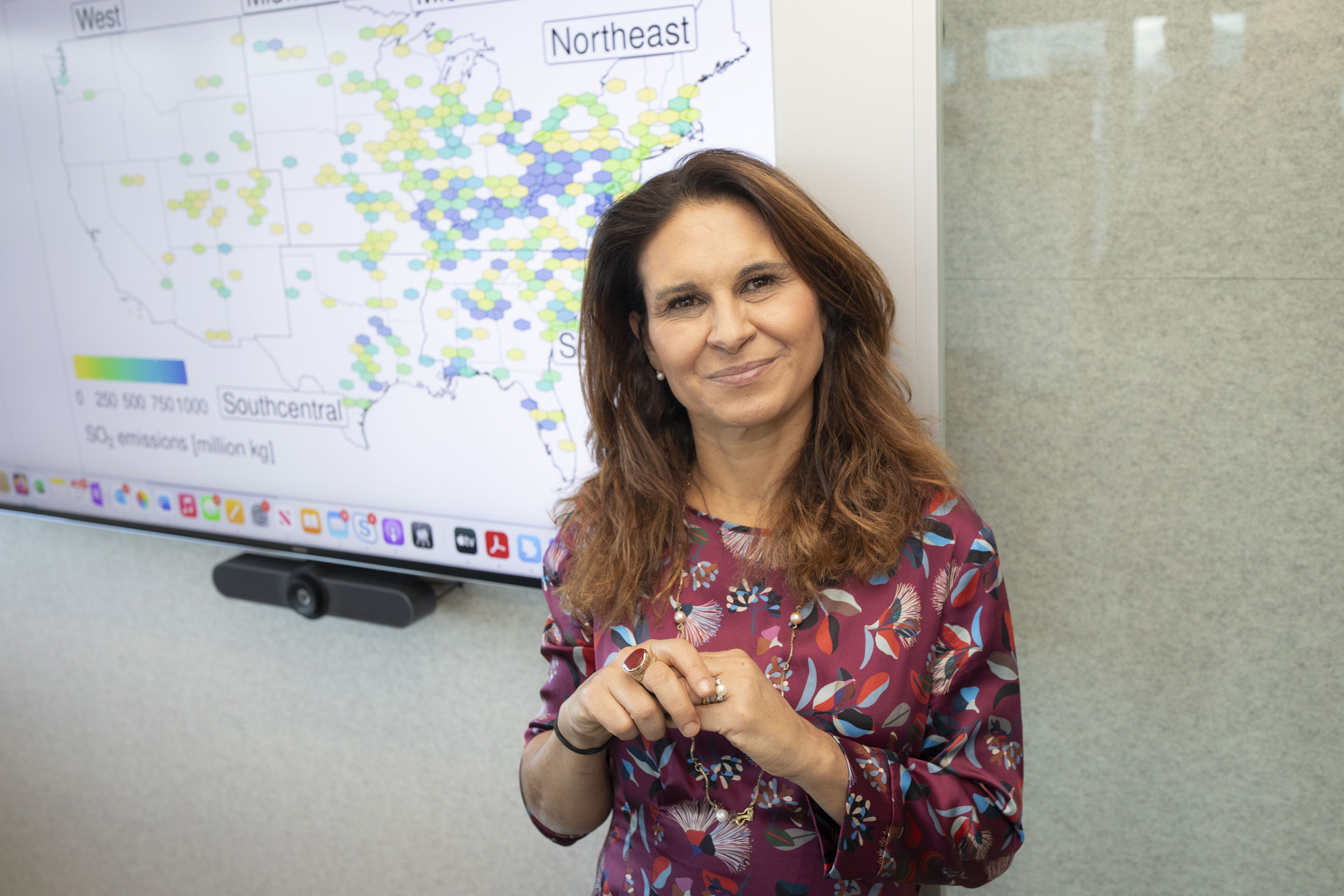
Kris Snibbe/Harvard Staff Photographer
Legacy of heading off deaths from industrial air pollution
Dominici details decades-old Harvard roots of latest findings showing particles from coal-fired power plants deadliest
The latest development made headlines this month. A new study indicates that the tiny particles released from coal-fired electric plants are the deadliest of all fuel-burning power sources, including power plant emissions and automobile exhaust.
The work, by researchers at the Harvard T.H. Chan School of Public Health, George Mason University, and the University of Texas, Austin, showed coal smoke’s fine particles are, in fact, twice as deadly, providing a regulatory roadmap for making the nation’s air cleaner and safer.
The finding was striking, but it was just the latest to emerge from decades of work on the impact of fine particles about 30 times smaller than the width of a human hair. That work began with the Harvard Six Cities Study, published 30 years ago this December in the New England Journal of Medicine. Six Cities was the first to link excess mortality in six U.S. cities to emissions of what are called particulate matter 2.5, or PM2.5. The findings prompted new regulations on industrial smokestack emissions.
Current regulations treat all PM2.5 as if they are equally damaging. The new work suggests that’s not so. Published in the journal Science, it examined death rates of those 65 and older living in the pollution plumes of coal-fired plants to national rates, finding those living downwind of these facilities to be 2.1 times more likely to die prematurely than those exposed to all kinds of PM2.5.
Francesca Dominici, the Clarence James Gamble Professor of Biostatistics, Population, and Data Science, has been studying fine particulate pollution for decades and is an author of the November study. Dominici, also the founding co-director of the Harvard Data Sciences Initiative, reflected on the legacy of Six Cities, the critical role of data science, and the likelihood recent work will prompt new regulation — or closure — of coal-fired power plants.
Q&A
Francesca Dominici
GAZETTE: The Harvard Six Cities Study was published in the New England Journal of Medicine 30 years ago. It has been hailed as a landmark in the fight against air pollution. What was so important about it?
DOMINICI: The Six Cities Study was published in 1993. It was led by Douglas Dockery and Frank Speizer, looked at air pollution in six different U.S. cities, and for the first time showed a clear relationship between exposure to fine particulate matter and mortality. It opened an entire area of research and is one of the first studies to really show the power of data in changing policy. It was just six data points, but those six data points did a lot of good. It was transformational.
GAZETTE: Did it impact your own research?
DOMINICI: My career started only four years later, as a postdoctoral fellow at the Bloomberg School of Public Health at Johns Hopkins University. I was the leader of a study called the National Mortality Morbidity Air Pollution Study, which looked at 100 cities. I worked with Jon Samet and Scott Zeger at Hopkins and Doug Dockery and Joel Schwartz at Harvard, and extended the Six Cities work to 100 cities.
Then I asked, “Why stop at 100? Why don’t we look at the entire continental U.S.?” So, when I moved to Harvard, I started to build a data platform using claims data from the Centers for Medicare and Medicaid Services. That allowed us to analyze what was basically the entire U.S. healthcare system, through individual claims data from Medicare and Medicaid services from every single ZIP code in the United States for the last 20 years.
Now we have over 600 million records for people older than 65 for the period 1999 to 2018. In 2017, we did the first study looking at the relationship between PM2.5 and mortality across the entire continental United States. It focused on whether current national ambient air quality standards of 12 micrograms per cubic meter are safe enough, and clearly they are not.
But if even low levels of PM2.5 are bad, how do we regulate it? Is it from car exhaust, power plant emissions? So, in the current study, Lucas Henneman, who was a postdoc in my lab and is now an assistant professor at George Mason University, took every single coal-fired power plant in the United States — there are 480 — and measured what’s coming out of the smokestack. He built machine learning and atmospheric chemistry models to figure out where the “coal PM2.5” — PM2.5 from burning coal — is traveling.
Then he linked that to our health data and asked the questions: Is the coal PM2.5 more or less harmful than general PM2.5? Which coal-fired power plant is most harmful?
“A small number of power plants account for the majority of deaths. And these power plants are located in areas where people with lower socioeconomic status live.”
GAZETTE: In this current study, you used sulfur dioxide — which can damage lungs, cause shortness of breath, tightness in the chest — as a marker for coal burning, but are there other potentially harmful chemicals in coal smoke?
DOMINICI: There is also nitrogen dioxide. PM2.5 is a chemical mixture and, when we talk about burning fossil fuels, the health impacts of coal are the worst. That’s why there’s a lot of discussion about the need to transition away from coal combustion as a way to create energy, ASAP.
GAZETTE: Could you have done this kind of continent-spanning work in 1993? What innovations have enabled it?
DOMINICI: Oh, no. You can’t possibly do fieldwork on the whole continental United States. This work is all based on harmonizing and linking huge data sources from government agencies, and it shows the power of data science. This is why I got into data science.
My goal is to solve problems and save lives. I realized that as I got into state-of-the-art computation and analytics, I could tackle these trillion-dollar policy questions. I’ve been blessed here at Harvard to be able to maintain and integrate and secure and compute on 600 million records.
We’ve seen the incredible explosion of data-science methodologies — like machine learning and causal inference — to provide policy-oriented solutions to the climate crisis. These data science methodologies are able to help us understand, from satellite data and atmospheric chemistry, where these power plants are and how their smoke travels. We can link exposure to coal PM2.5 to Medicare claims, which we couldn’t do before, and learn from these integrated data the causal effects of coal PM2.5 on mortality.
There has been a progression in the level of sophistication and scientific rigor that allows us to do this type of study that I would say even two years ago, we couldn’t do. Scientific rigor is paramount to achieving a policy change.
GAZETTE: Let’s talk about the findings from this latest study. What do you think is most important coming out of this?
DOMINICI: There are three things that really surprised me. One, we found that the relative risk of mortality from coal pollution is twice the risk from all PM2.5. All of the EPA’s cost-benefit analyses need to be updated because they rely on mortality from PM2.5 regardless of its source. And coal-fired power plants are much, much more harmful than we thought.
Two — I have to give credit to Lucas for this — we were able to track coal pollution and point out the power plants that are the top killers. A small number of power plants account for the majority of deaths. And these power plants are located in areas where people with lower socioeconomic status live.
And third, this scrubber technology is very effective. We tracked mortality over time and were able to see the impact on mortality before and after scrubbers were installed. You really see the number of deaths go down.
GAZETTE: Do you think this will drive policy changes?
DOMINICI: It creates a tremendous amount of pressure to shut down the most harmful coal-fired power plants in the U.S. or replace them with natural gas. It empowers the local governments in understanding the harmful effects of the coal-fired power plants that are in their region via our visualization. If you have to rely on them, then we shouldn’t allow any coal-fired plants without scrubber technology.
Globally, there’s been a tendency to think that we can still rely on coal for energy, but I hope the message is we need to not rely on coal. Coal-fired power plants kill in the U.S. and are going to kill elsewhere. That’s clear.
GAZETTE: Where are the health impacts from coal-fired power plants largest?
DOMINICI: The biggest impact is in the Midwest, the mid-Atlantic, and Southeast because that’s where most of the coal power plants are.
GAZETTE: Are you anticipating these results causing a stir, generating opposition from industry groups? Or have the negative health impacts of PM2.5 become accepted?
DOMINICI: I’ve been under scrutiny my entire career, and I’m used to it. I’m expecting there’s going to be pushback, especially from the coal industry, because it’s going to change the dynamics of the conversation. Until this study, we have always said that you need to regulate PM from all the different sources, but now we are putting a finger on one of the sources.








